Straight sofas: types, sizes and selection rules
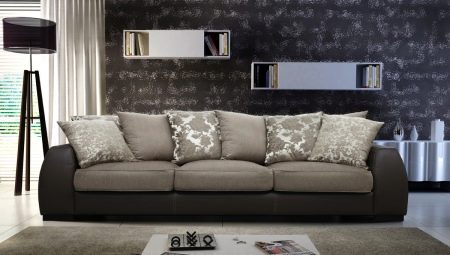
The sofa is an important piece of furniture in the interior of every apartment. Convenient, practical and comfortable, it can be used as a seat for households and guests, or become a comfortable sleeping place. Direct models are especially popular among buyers. Compact, oversized, in neutral colors or bright, "flashy" - solutions are available for sale for any room and interiors. Let's figure out what the pros and cons of this furniture, what types are offered by manufacturers, and how to choose the best option.


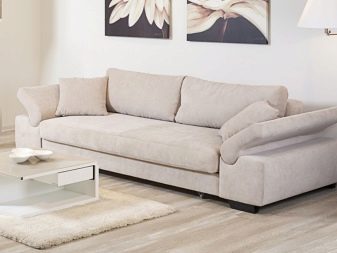
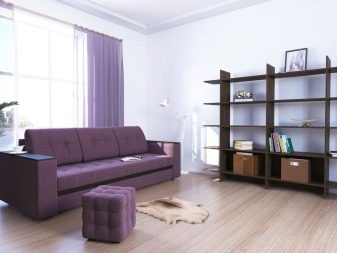
Advantages and disadvantages
Before buying a straight sofa, you need to study its features in detail. The advantages of such models include a large assortment. There are miniature options for small rooms, solid ones for spacious rooms, or small colorful ones for arranging a children's bedroom. The price range is also wide: there are both inexpensive items for people on a limited budget and expensive classic furniture made from natural materials.
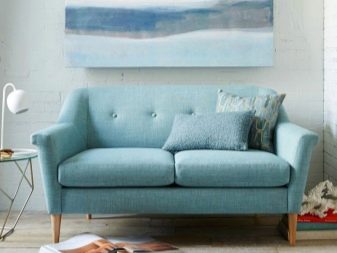
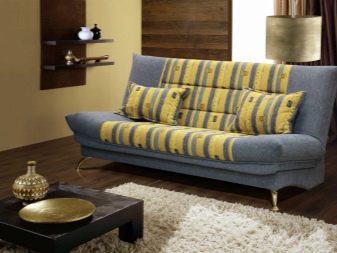
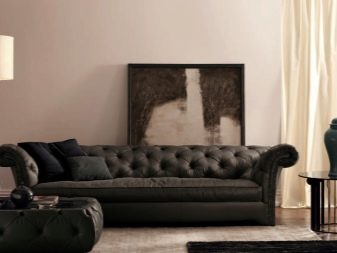
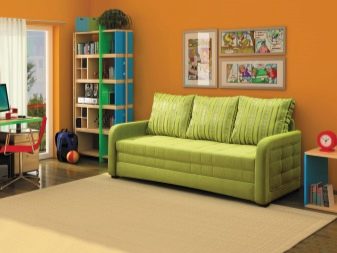
Another important advantage is its versatility.
Most modern models have spacious drawers, compartments or shelves. They can store bedding or textiles. This makes the sofa more comfortable to use. Direct configuration models can be placed in the living room, bedroom, living room or kitchen. Furniture well-chosen in color and style will fit into any interior.
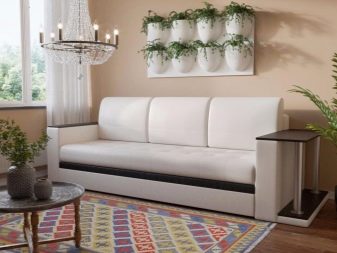
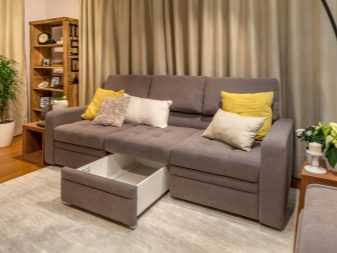
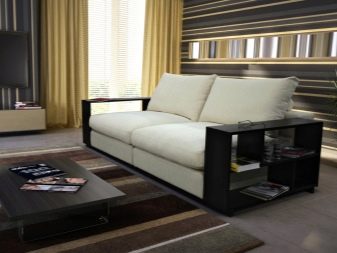

Straight sofas also have some disadvantages.For example, the disadvantages include the cumbersome design of some overall models. It will not be easy to transport them, bring them into the entrance and into the apartment. Another drawback is the unreliability of some transformation mechanisms (provided for folding solutions).
If the sofa is laid out daily, the transforming device may soon fail.
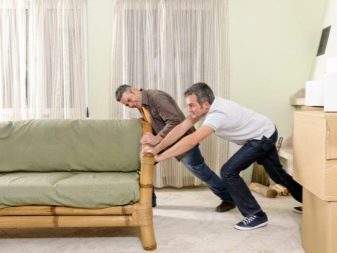

What are they?
Straight sofas are classified according to several criteria. They are divided into 2 large groups.
- Stationary. They are not equipped with a transformation mechanism, due to which they cannot be decomposed. Such solutions are ideal for location in an elongated room, since they have small depth indicators. Stationary models with a high back are inexpensive, durable and reliable, but they are uncomfortable to sleep on.
- Folding (transformers). A transformation mechanism is provided in these products, due to which they are able to "turn" into a full-fledged sleeping place. Convertible sofas are often bought for arranging small bedrooms, in which, due to the small area, it is not possible to install a full double bed. Products with a berth can have various fillings, but furniture with an orthopedic effect is of particular value.
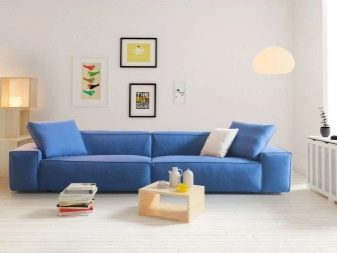
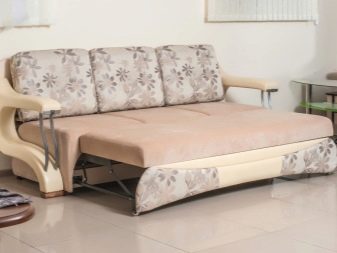
Linear sofas come with or without armrests. Such structural elements can be soft or rigid.
Padded armrest solutions allow you to sit comfortably in a seated or reclining position.
You can lean on rigid elements. Straight sofas can have a padded pouf in the set, which provides more comfort while relaxing.
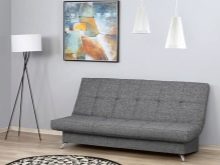

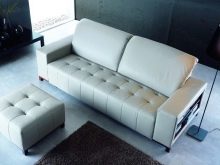
Overview of transformation mechanisms
Sliding sofas with a straight configuration can be equipped with one or another transforming mechanism. They all have their own characteristics. When choosing a folding mechanism, several important parameters should be taken into account - the intensity of the use of the berth and the free squaring of the room. Let's consider the most popular mechanisms.
- "Book". One of the simplest and most reliable transformation variations. To get a berth, the seat should be lifted up until it clicks, while the backrest will lower horizontally. Next, you need to return the seat to its original position. Sofas with this mechanism do not take up much space in the bedroom. The furniture has several compartments for storing things or bedding. The mechanism itself can withstand intense loads, while it is difficult to break it.
The main disadvantage is the need to place the sofa away from the wall - the product can be moved apart only if there is free space behind it.
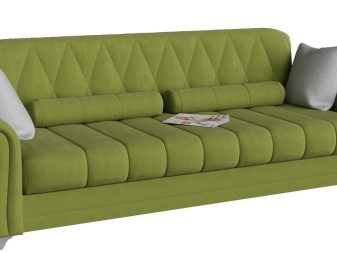
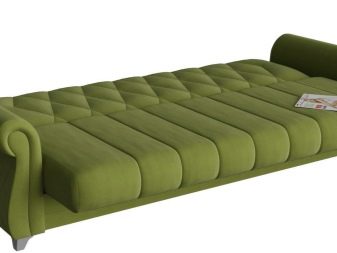
- "Elf". One of the simplest systems. To get a berth, you just need to lower the armrests. The advantages of such sofas include their compactness, orthopedic surface, provided capacious storage compartments. The downside is the possibility of getting a small berth.
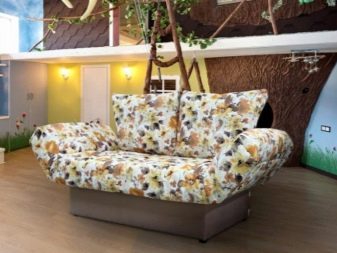

- "Tango". An improved version of the book mechanism. In another way it is called "click-gag". Unlike the "book", the "tango" models can be fixed not in 2, but in 3 positions - sitting, lying and reclining. The principle of operation of these two mechanisms is similar. The advantages of the "click-gag" mechanism include the ability to fix furniture at an angle, simplicity, reliability and durability. Of the shortcomings, they note the impossibility of installing the sofa close to the wall. Transformation will take effort, which is also considered a disadvantage.
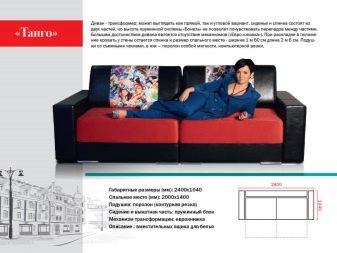

- "Eurobook". To transform, the seat must be pushed forward (some models are equipped with special rollers), as a result of which an empty space is formed, which has the same dimensions as the backrest. The backrest is lowered into the resulting "niche" - the sleeping place is ready. Models with such a mechanism are able to form a spacious place for a night's rest. They are durable and reliable, making them ideal for your daily transformation.
Another advantage is the ability to install close to the wall. The disadvantage is that most models have a deep seat, which makes it inconvenient to lean on the back.
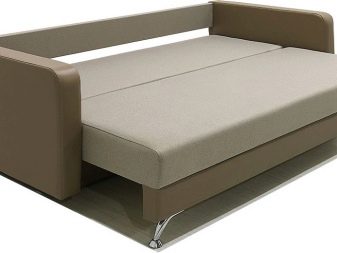

- "Pantograph"... By the principle of operation, this mechanism is similar to the "Eurobook". To transform, slightly pull the seat up and then forward. The back is lowered into the resulting space. The advantages of sofas with a "pantograph" mechanism include the possibility of forming a spacious berth, easy transformation (a child can expand the product), and the presence of a storage compartment. Disadvantages - large dimensions of the seat, higher price for sofas due to a complex transforming mechanism.

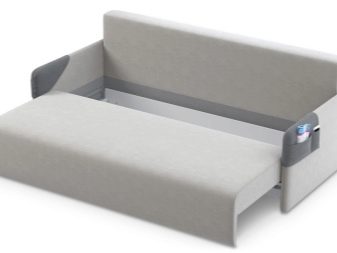
- "Accordion". The decomposition of the sofa is carried out similarly to the movement of the bellows of an accordion. When assembled, the product is compact, but when transformed, it can form a two- or three-sleeping place. It should be borne in mind that at least 1.5 meters of free space will be needed to decompose furniture. The disadvantages of the "accordion" are the application of considerable efforts for transformation, as well as the risks of damage to the floor when moving the supporting parts of the structure.
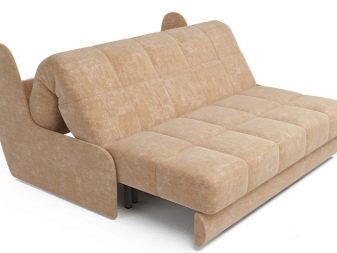
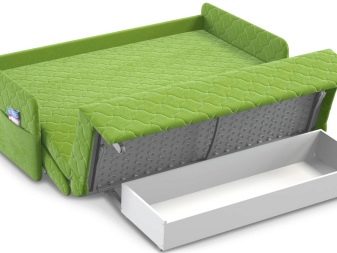
- "Roll-out". To transform, roll out the seat, then fold back its upper part. Sofas equipped with this mechanism are compact in the assembled position, but when expanded they form a spacious surface. The disadvantages include the risks of damage to the floor cladding when the seat is rolled out and the low height of the bed.
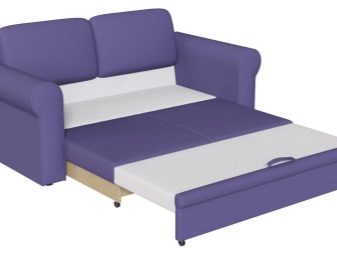
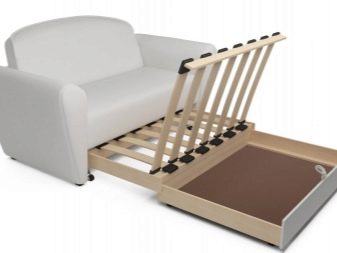
- "French clamshell". The mechanism provides for the folding of the berth "accordion" under the seat. For transformation, the front of the sofa is pulled out, after which the 3 sections are laid out in sequential order. Products with such a mechanism are compact, and when expanded, they form a spacious and comfortable sleeping surface. The disadvantages include the fragility of the mechanism, the lack of boxes, thin mattresses.
Such furniture is not suitable for daily sleep, but it will become indispensable if relatives come from afar or stay overnight guests.

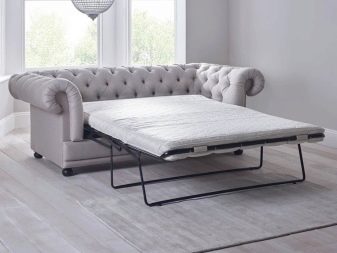
- "American clamshell". To convert the sofa into a bed, you need to raise the seat, after which 3 additional sections will open in turn. This transforming system is easy to operate and reliable. The only drawback is not a very comfortable sleeping place due to the large seams formed when joining the sections. They can be "felt" during sleep and cause discomfort to the resting person.
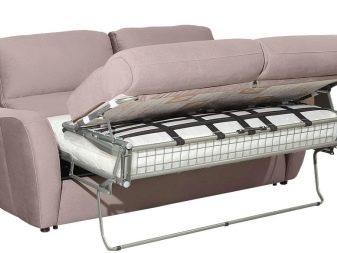
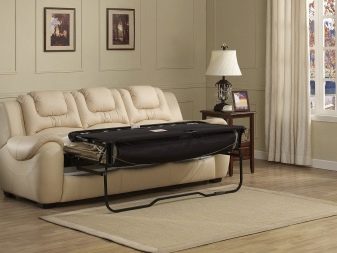
- "Dolphin". This mechanism is often equipped with structures with both straight and angular configuration. For transformation, it is necessary to roll out the lower part of the sofa, then pull out the pillow from it (for this purpose, handles or hinges are provided). The mechanism is simple, transformation takes place effortlessly. With intensive operation, there are great risks of rapid system failure. If you use the bed frequently, the sofa will last no more than 5 years.

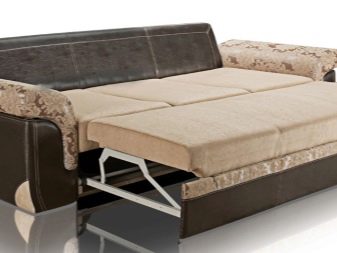
Materials (edit)
Various materials are used for the frame, padding and sheathing. All of them have different durability, properties, performance and technical characteristics. Let's consider the materials used by manufacturers in more detail.
Frame
This is the basis of the whole structure. The frame directly depends on what maximum load the sofa can withstand. The most unreliable is the basis of chipboard. Most often, this material is used for the manufacture of budget furniture. Under severe stress or during sleep, such a base may break, which will require replacement of the product. Furniture with a natural wood frame is considered more reliable and durable. It can be birch, oak, beech, pine or spruce.
The most durable are metal bases. However, metal structures add additional weight to the product, which makes these sofas heavy.
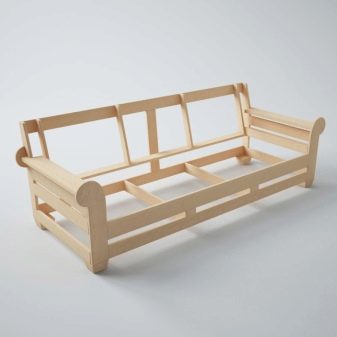

Filler
Previously, foam rubber was used as a filler in most products. This material is cheap but short-lived.... It quickly "squeezes" and becomes unusable. Now foam rubber is used in the manufacture of budget sofas. Such products are inexpensive, but with intensive use they will soon require replacement.
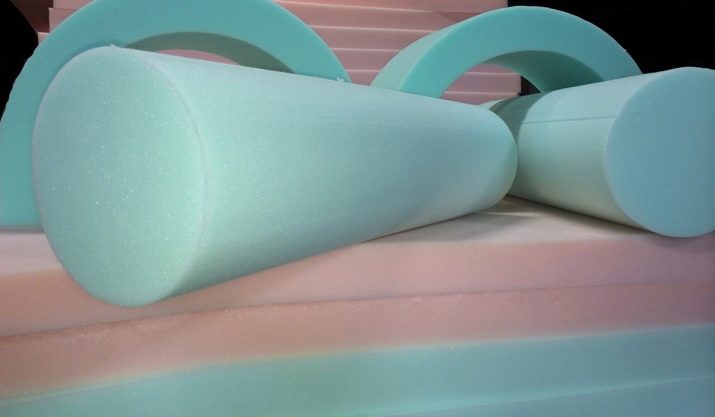
The following materials are also used as a filler:
- synthetic winterizer - artificial filler, which is cheap and has good performance;
- holofiber - hypoallergenic material with a long service life;
- spring block - the most practical filler with optimal softness.
Experts advise buying sofas with independent spring units. Such furniture will cost more, but the convenience of its use is higher than that of other materials.
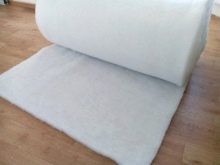
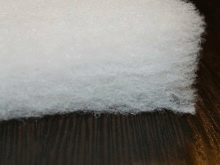
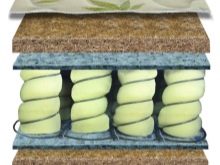
Upholstery
The appearance of the product, its service life and performance will depend on this material. The upholstery should "give" pleasant tactile sensations, be hypoallergenic, easy to clean and breathable.
Modern manufacturers offer an extensive selection of upholstery materials.
- Microvelor. It is soft and pleasant to the touch. It is resistant to wear and tear, does not accumulate static electricity. The material is hypoallergenic, due to which it is often used in the manufacture of furniture for children.
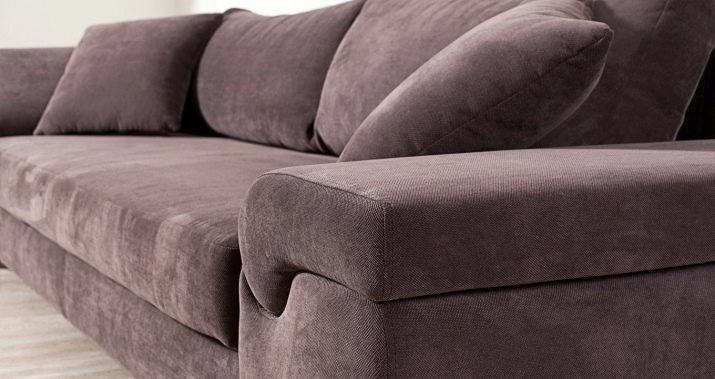
- Flock. This material is highly durable. He is able to withstand mechanical stress, so he is recommended to give preference when choosing furniture to a family with animals. Flock is easy to clean and retains its presentability for a long time. Its only drawback is the ability to absorb foreign odors. Due to this feature, products with flock upholstery are not recommended to be placed in the kitchen.
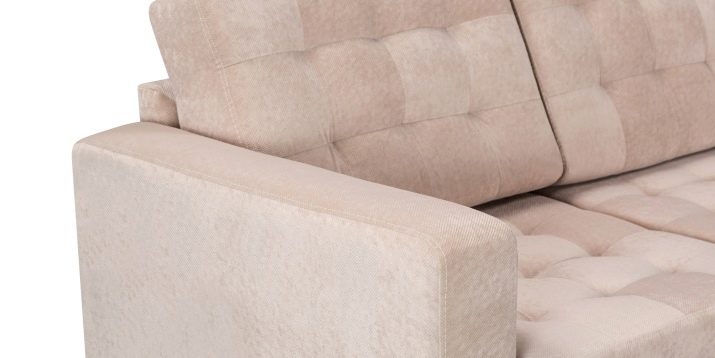
- Jacquard. Strong, durable and wear-resistant material. This fabric is impregnated with specialized compounds so that it “repels” various impurities. Jacquard belongs to the group of expensive upholstery.

- Chenille... This material is made from natural and artificial raw materials. It is easy to clean, quick and easy to clean, and is aesthetically pleasing.
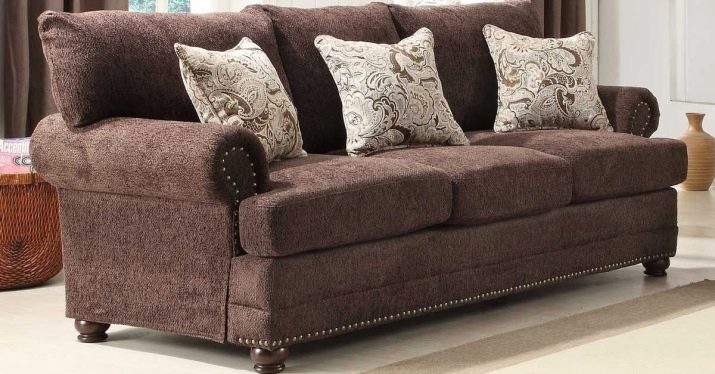
- Faux suede... It is a synthetic material with an uneven color. Faux suede sofas can store static electricity. They "attract" dirt and dust, "are afraid" of moisture. The advantages of the material include resistance to deformation, color retention when exposed to UV rays, excellent breathability.
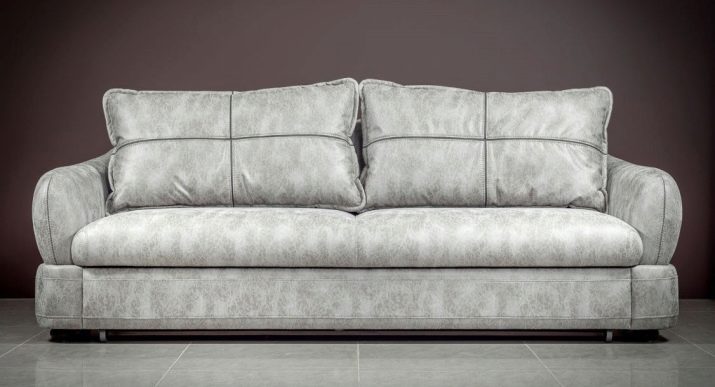
- Microfiber. Outwardly, this material is similar to faux suede. Due to the Teflon coating, this upholstery "repels" dust, various dirt and moisture. Microfiber furniture is not recommended to be bought in apartments with pets.
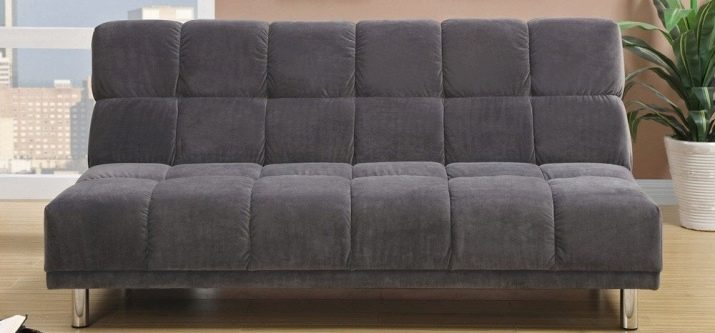
Popular types of upholstery also include scotchguard, arpatek, tapestry, artificial and natural leather. The last solution is the most reliable, practical and expensive. Natural leather is used in the manufacture of luxury classic furniture. Such upholstery looks stylish, it is resistant to mechanical stress, and easy to clean. The disadvantages include a meager selection of colors, damage from fire.
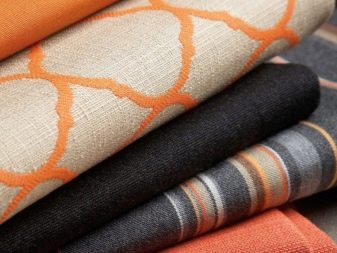
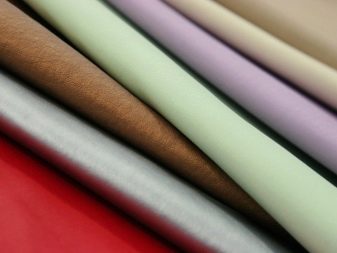
If you like the way leather looks, but there is no financial opportunity to purchase furniture with natural upholstery, you should pay attention on solutions from eco-leather or leatherette... These materials do not absorb odors or moisture. They are soft and easy to clean.
However, the owners of artificial leather sofas complain about the stickiness of the material, its instability to abrasion and fire.
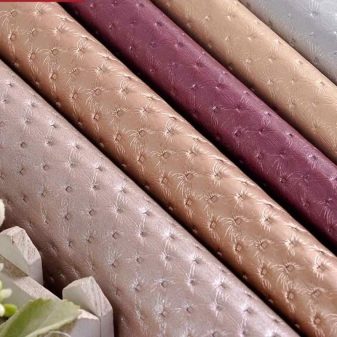

Dimensions (edit)
When buying a straight sofa, it is necessary to take into account 2 parameters of its dimensions - in the folded and unfolded position. Products can be of various sizes. Let's imagine the dimensions of popular models:
- width varies from 90 to 220 cm;
- popular lengths from 150 to 230 cm (there are also longer models on sale that are 4 meters in length);
- the height varies from 50 to 150 cm;
- seat depth 50 to 90 cm.
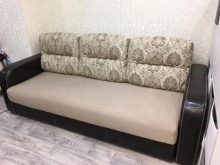
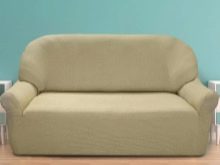

These are average values.Manufacturers also offer custom sizes of sofas. Depending on the model, their length can reach 2350, 2400, 2500, 3200 mm.
There are also several categories of sofas that differ in size.
- "Baby". Due to its compact size, it is suitable for rooms that are too small in area. The length of these options starts from 120 cm in length and 60 cm in width.
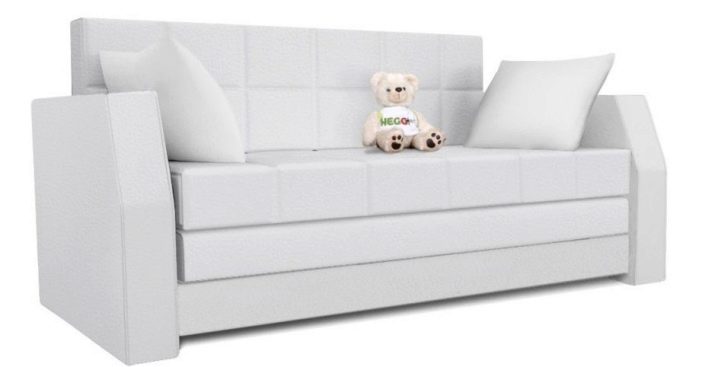
- "Lorries" or children's sofas. The length of such products starts from 90 cm (maximum 200 cm). The popular size is 170x90 cm (for models with the option to lay out forward).
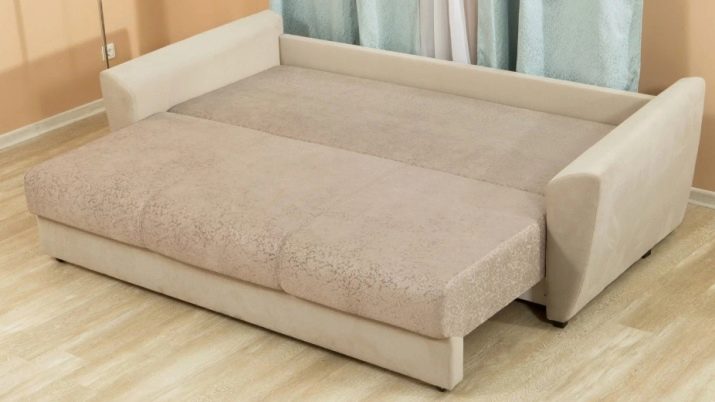
- Double solutions. Most popular options. The products are suitable for use in apartments and houses, as well as in offices. The standard dimensions are 1700 mm in length and 1000 mm in width. Most of the models are available in lengths of 250, 260 and 270 cm.
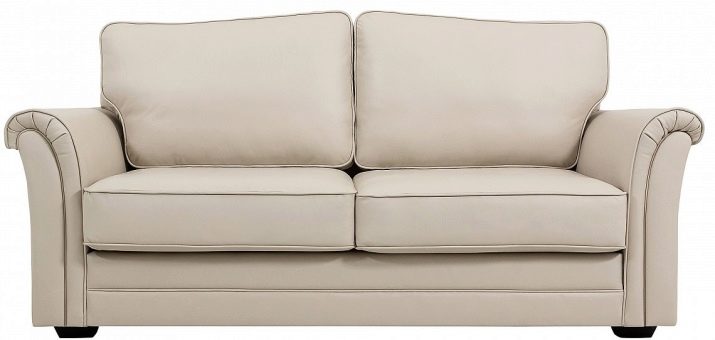
- Triple models. These are oversized and spacious sofas, which, when transformed, form a spacious sleeping place. Solutions with dimensions of 2600 x 1100 mm, 2700x900 mm, 2000x2000 mm are in demand.
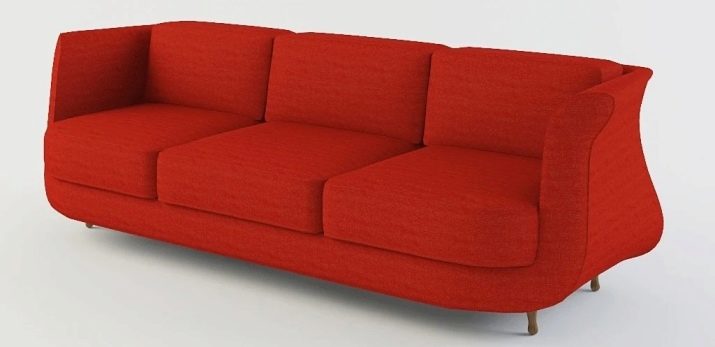
- Large four-seater sofas. The length of such products can be from 4 to 5 meters.
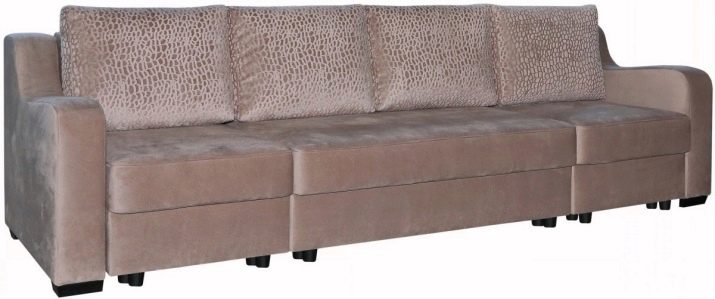
When choosing dimensions the area of the room, the required number of seats and the height of the person should be taken into account, who will use it as a sleeping place (for transformer models).

Variety of colors
The market for upholstered furniture abounds in a huge number of sofas with upholstery in various colors. Classic white sofas remain in vogue. Such solutions help to "refresh" the interior and visually expand the space in small rooms. The delicate and popular colors include beige and pastel colors. Unlike white furniture, such products will be less easily soiled.
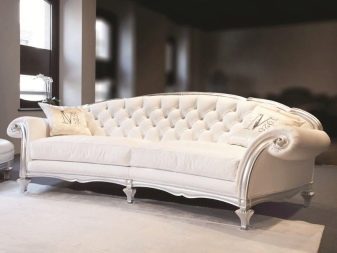
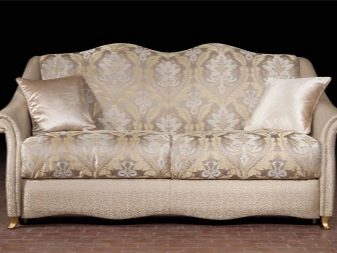
If you plan to focus on the sofa in the room and highlight it among other pieces of furniture, you should give preference to bright and "juicy" colors.
For example, the highlight of the interior will be furniture in purple, red, orange, green, burgundy tones. Products with "flashy" colors are not recommended to be placed in rooms with a bright design. Sofas can be black. This is a classic that will never go out of style. Such pieces of furniture are suitable for spacious rooms, but they will look out of place in small rooms. Products with black upholstery will fit perfectly into formal and business environments.
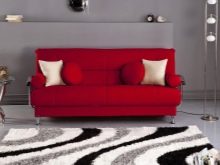
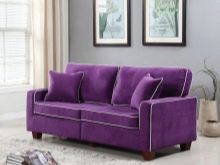
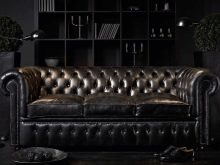
Styles
Designers have more than 50 main styles in which straight sofas are made. Let's consider the most popular ones:
- high tech - characterized by simple geometric shapes, monochromatic "calm" colors;
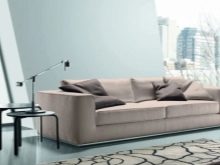
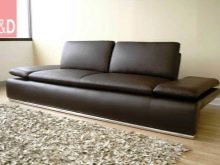

- loft - this style is characterized by bright colors, the use of seemingly incompatible materials (plastic, metal, genuine leather);
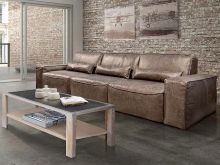


- eco - assumes the use of natural materials, sofas in this style are simple, have no decor;
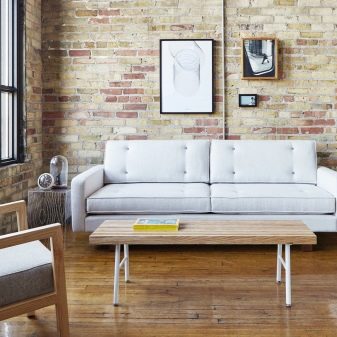
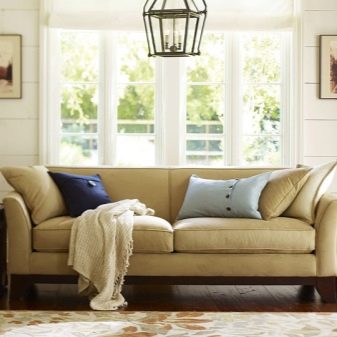
- retro - sofas in this style are distinguished by streamlined shapes, the presence of wooden or chrome-plated legs is required;
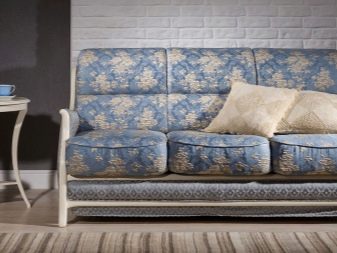

- classic - furniture in classic style is decorated with hand-carving, gilding, decorative overlays;
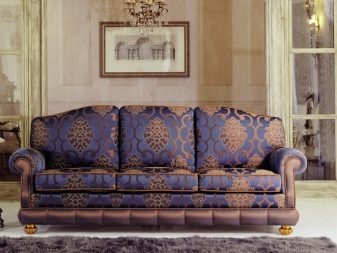

- baroque - this style is characterized by complex figures, carved legs (supports in the form of animal paws are often found), wooden backs decorated with carvings.
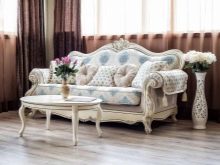
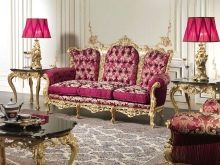
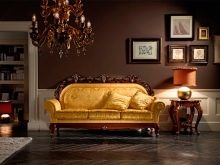
Popular styles also include empire, Italian, country, oriental and others.
How to choose?
The sofa is bought for more than one year, so you should carefully consider its choice. There are some tips to consider before purchasing furniture.
- Dimensions (edit)... In order not to be mistaken with the dimensions, it is important to first take measurements in the room where the sofa is supposed to be installed. For small rooms, it is best to take a closer look at compact models in light colors.
- Quality. Reliable and durable products are made of durable materials (this applies to the frame and upholstery).Smooth seams, the absence of external defects, and the smooth operation of the transformation system will also tell about the high quality of the furniture.
- Functionality. If you need additional sleeping space, models with the possibility of folding are purchased. For a one-room apartment, solutions with a "book", "eurobook" or "click-gag" transformation system will be a good choice.
- Additional storage compartments. They will become irreplaceable if the apartment does not have enough space for bedding.
- Design. The sofa should be in harmony with the interior and other existing furniture in terms of style and color palette.
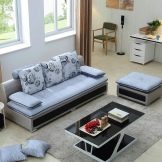
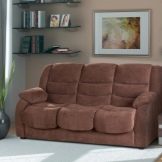
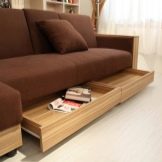

Special attention should be paid to the choice of a direct sofa in the kitchen.
Difficult conditions are often observed in this room - high humidity, temperature drops. In addition, the upholstery "runs the risk" of being stained with food or accidentally spilled drinks. Therefore, for the kitchen, it is worth choosing furniture with upholstery that does not absorb odors and is easy to wet clean. The ideal solution for the kitchen would be the purchase of a leather sofa or with an imitation leather surface.
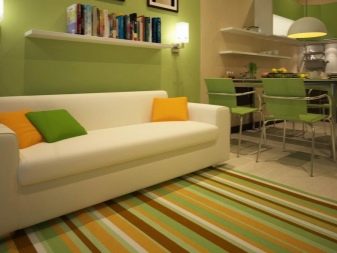
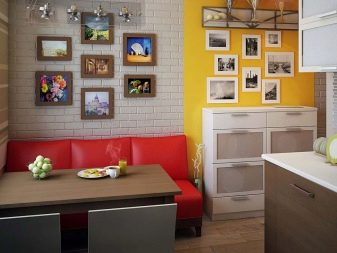
Where to put it?
It is not difficult to find a place for a straight sofa in the house - there would be free space. If we talk about the kitchen, then this furniture should be placed in the dining area. A soft sofa will add comfort and create a cozy atmosphere.

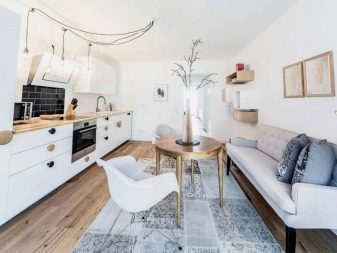
If the installation of the sofa is planned in the bedroom, it is recommended to place it near the wall. This arrangement will help to maintain useful free space in the room.
It is worth considering that for folding sofas, you need a place to transform into a bed.


In spacious living rooms, sofas are placed in the center of the room or next to one of the walls. The first option involves the use of furniture with a presentable back side. Otherwise, the island installation would be inappropriate. By placing furniture, it is important to consider the location of the TV (it is best to have the screen in front of the sofa).
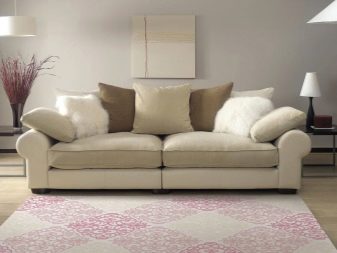
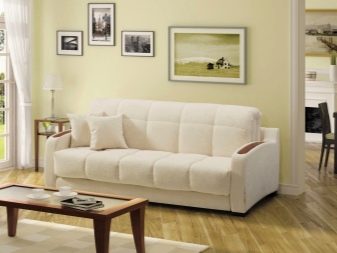
Beautiful examples in the interior
Let's imagine a small photo gallery with images, which captures the successful placement of straight sofas in various interior styles.
- The room is decorated in a classic style. The centerpiece is an elite sofa in light colors with cushions.
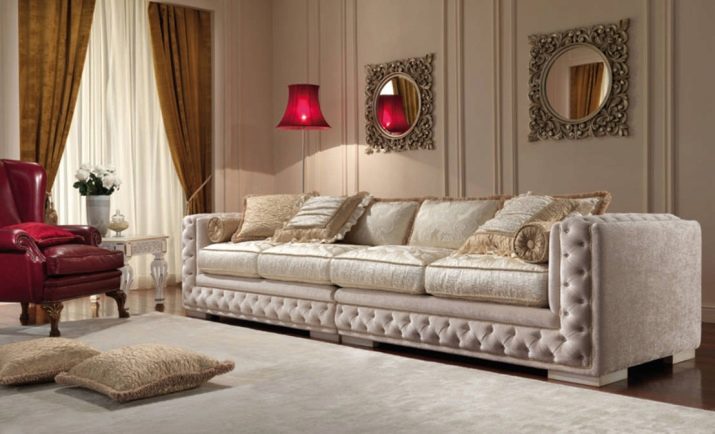
- The example shows how you can use a compact straight sofa in a minimalist style.
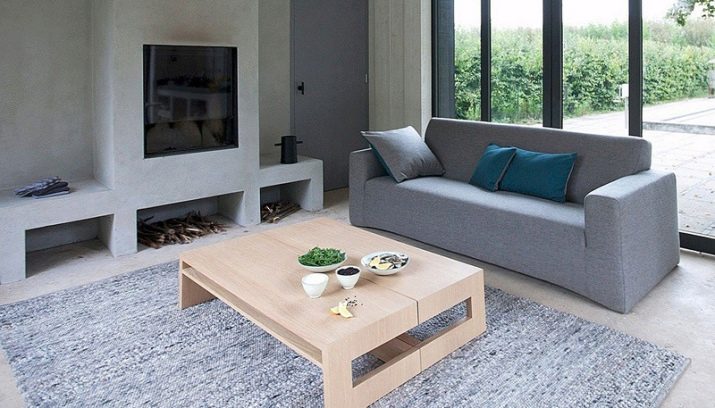
- Thus, you can zone the space in the living room.

- The example illustrates how you can competently furnish the dining area in the kitchen with the help of a soft sofa.
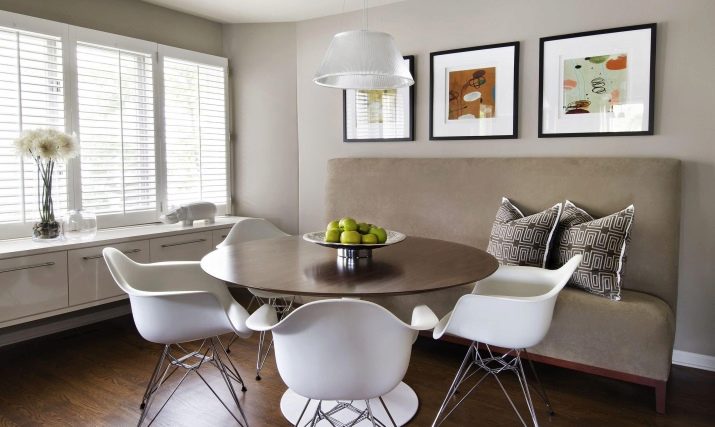
The sofa sets the "tone" for the entire interior. If you choose a high-quality model and take care of it correctly, the furniture will last for many years, while maintaining functionality and aesthetics.
For tips on choosing sofas and an overview of models, see the following video.








